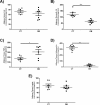Obesity-induced diet leads to weight gain, systemic metabolic alterations, adipose tissue inflammation, hepatic steatosis, and oxidative stress in gerbils (Meriones unguiculatus)
- PMID: 28265495
- PMCID: PMC5337087
- DOI: 10.7717/peerj.2967
Obesity-induced diet leads to weight gain, systemic metabolic alterations, adipose tissue inflammation, hepatic steatosis, and oxidative stress in gerbils (Meriones unguiculatus)
Abstract
Background: Nowadays, the number of obese people in the world has reached alarming proportions. During the expansion of adipose tissue, a number of functions such as activation and release of cytokines and hormones may be affected. This leads the body to a pro-inflammatory pattern, which may affect the proper functioning of many tissues. Thus, studying the mechanisms by which obesity induces physiological disorders is necessary, and may be facilitated by the use of animal models, in particular rodents. We sought to characterize the metabolic and adipose tissue changes resulting from a diet rich in fats and simple sugars in gerbils.
Methods: We divided 14 gerbils into two experimental groups that received a diet rich in simple carbohydrates and fats with 5,86 kcal/g (OB, n = 7) or a standard diet with 4.15 kcal/g (CT; n = 7) for 11 weeks. The animals had free access to water and food. The animal weight and food consumption were measured weekly. Blood, adipose tissue and liver of each animal were collected at the end of experiment. The following parameters were determined: cholesterol (COL), triglycerides (TGL) and glycemia (GLI) in the plasma; cytokines (IL-6, IL-10 and TNF-α) and hormones (adiponectin and leptin) in adipose tissue; activity of superoxide dismutase (SOD) and catalase (CAT), extraction and differentiation of fat and histology in liver.
Results: The consumption of a diet rich in simple carbohydrates and fats led to increased total body weight and increased relative weights of liver and adipose tissue. In addition, we observed increased fasting glucose levels and circulating triglycerides, along with high TNF-α production in adipose tissue and increased total fat, cholesterol and triglyceride contents in the liver, contributing to higher intensity of hepatic steatosis. On the other hand, the animals of this group showed depletion in the enzyme activity of SOD and CAT in the liver, as well as reduction of IL-10 and adiponectin levels in adipose tissue.
Discussion: High intake of saturated fat and simple carbohydrates establish the gerbil as an experimental model for the study of metabolic and hepatic abnormalities resulting from obesity.
Keywords: Animal models; Diet-induced obesity; Lipid metabolism; Obesity.
Conflict of interest statement
The authors declare there are no competing interests.
Figures





Similar articles
-
Methionine restriction prevents the progression of hepatic steatosis in leptin-deficient obese mice.Metabolism. 2013 Nov;62(11):1651-61. doi: 10.1016/j.metabol.2013.06.012. Epub 2013 Aug 5. Metabolism. 2013. PMID: 23928105
-
Dietary capsaicin reduces obesity-induced insulin resistance and hepatic steatosis in obese mice fed a high-fat diet.Obesity (Silver Spring). 2010 Apr;18(4):780-7. doi: 10.1038/oby.2009.301. Epub 2009 Oct 1. Obesity (Silver Spring). 2010. PMID: 19798065
-
[Simple obesity in children. A study on the role of nutritional factors].Med Wieku Rozwoj. 2006 Jan-Mar;10(1):3-191. Med Wieku Rozwoj. 2006. PMID: 16733288 Review. Polish.
-
Role of pentoxifylline in non-alcoholic fatty liver disease in high-fat diet-induced obesity in mice.World J Hepatol. 2015 Oct 28;7(24):2551-8. doi: 10.4254/wjh.v7.i24.2551. World J Hepatol. 2015. PMID: 26523207 Free PMC article.
-
Recent advances in the relationship between obesity, inflammation, and insulin resistance.Eur Cytokine Netw. 2006 Mar;17(1):4-12. Eur Cytokine Netw. 2006. PMID: 16613757 Review.
Cited by
-
Inhibition of adiposity and related metabolic disturbances by polyphenol-rich extract of Boswellia serrata gum through alteration of adipo/cytokine profiles.Inflammopharmacology. 2019 Jun;27(3):549-559. doi: 10.1007/s10787-018-0519-4. Epub 2018 Aug 1. Inflammopharmacology. 2019. PMID: 30069718
-
Antioxidant Properties of Fucoidan Alleviate Acceleration and Exacerbation of Hippocampal Neuronal Death Following Transient Global Cerebral Ischemia in High-Fat Diet-Induced Obese Gerbils.Int J Mol Sci. 2019 Jan 28;20(3):554. doi: 10.3390/ijms20030554. Int J Mol Sci. 2019. PMID: 30696078 Free PMC article.
-
Obesity as Inducer of Cognitive Function Decline via Dysbiosis of Gut Microbiota in Rats.Brain Sci. 2024 Aug 12;14(8):807. doi: 10.3390/brainsci14080807. Brain Sci. 2024. PMID: 39199499 Free PMC article.
-
A 2-Min Transient Ischemia Confers Cerebral Ischemic Tolerance in Non-Obese Gerbils, but Results in Neuronal Death in Obese Gerbils by Increasing Abnormal mTOR Activation-Mediated Oxidative Stress and Neuroinflammation.Cells. 2019 Sep 22;8(10):1126. doi: 10.3390/cells8101126. Cells. 2019. PMID: 31546722 Free PMC article.
-
Evaluation of the Effects of Diet-Induced Obesity in Zebrafish (Danio rerio): A Comparative Study.Nutrients. 2024 Oct 7;16(19):3398. doi: 10.3390/nu16193398. Nutrients. 2024. PMID: 39408365 Free PMC article.
References
-
- Araújo NS, Mundim MJS, Gomes MA, Amorim MRR, Viana JC, Queiroz RP, Rossi MA, Cury MC. Giardia duodenalis: pathological alterations in gerbils, Meriones unguiculatus, infected with different dosages of trophozoites. Experimental Parasitolology. 2008;118:449–457. doi: 10.1016/j.exppara.2007.10.007. - DOI - PubMed
LinkOut - more resources
Full Text Sources
Other Literature Sources
Miscellaneous

